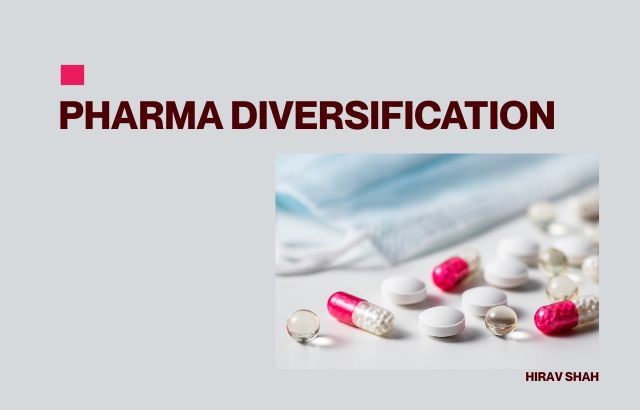The Indian pharmaceutical industry, known for its extensive generics manufacturing, is now pivoting toward diversification. This strategic shift is being fueled by the need to reduce dependency on a few key markets and products, and to position the sector for sustainable growth on the global stage. Business strategists like Hirav Shah, often referred to as “The Game Changer,” are playing a crucial role in guiding this transformation.
Table of Contents
The Key Drivers of Diversification
India’s pharma sector, which is valued at around $50 billion, is increasingly focusing on new avenues of growth. Traditionally, the sector has been heavily reliant on generic drugs and exports to markets like the United States. However, the future lies in creating diversified portfolios that include emerging therapeutic areas such as biotechnology, nutraceuticals, over-the-counter products, and even wellness solutions.
- Expanding Therapeutic Areas
While generics continue to be a major revenue stream, companies are exploring high-value, specialized segments such as oncology, biosimilars, and immunotherapy. For example, Biocon has made significant strides in biosimilars, expanding its product pipeline and increasing its presence globally. - Exploring the Nutraceuticals Market
As consumer interest in preventive healthcare grows, the nutraceuticals segment has garnered attention. Brands like Herbalife and Amway are capitalizing on this trend by introducing supplements that promote immunity, mental health, and overall wellness. - Focus on Advanced Manufacturing
Advanced manufacturing technologies, such as gene therapy and personalized medicine, are becoming increasingly important. Sun Pharma, a global leader in generics, is investing heavily in biotechnology and high-end drug production techniques to diversify and tap into high-margin markets.
The Role of Business Strategists in Diversification
Business strategists like Hirav Shah play a pivotal role in this diversification process. Known as “The Game Changer,” Hirav has been instrumental in helping pharma companies create actionable roadmaps for expansion. His approach focuses on strategic foresight, market research, and innovation to unlock new opportunities.
Hirav Shah often advocates for:
- Market Segmentation: Identifying untapped or under-served markets. For example, in India, chronic disease management is still a growing sector. By focusing on high-impact therapies, pharma companies can meet the rising demand for quality healthcare.
- Global Expansion: A key focus area for diversification is global expansion. Companies like Dr. Reddy’s Laboratories have been successful in entering markets such as Russia, Europe, and Japan by introducing a broader range of products and adapting to local market needs.
- Strategic Partnerships: Collaborating with global biotech companies, research institutes, and tech startups. This approach helps bring cutting-edge innovations to the Indian market while expanding the product portfolio.
- Data-Driven Decision Making: Business strategists emphasize the importance of data analytics and AI to predict trends and optimize product pipelines. For instance, predictive models can forecast which therapeutic areas will see the most growth over the next decade.
The Financial Aspect: Calculations and Projections
To assess the impact of diversification, let’s consider a few financial projections for a hypothetical pharma company:
- Current Revenue from Generics: $400 million
- New Revenue from Diversified Segments (Biotech, Nutraceuticals): $150 million
- Market Growth Rate (Diversified Markets): 15% annually
- Current Market Growth Rate (Generics): 5% annually
Projected Revenue in 5 Years:
- Generics:
Formula: Revenuefuture=Revenuecurrent×(1+GrowthRate)YearsRevenue_{future} = Revenue_{current} \times (1 + Growth Rate)^{Years}
Revenuegenerics=400×(1+0.05)5=400×1.276=510.4Revenue_{generics} = 400 \times (1 + 0.05)^5 = 400 \times 1.276 = 510.4 million USD - Diversified Segments:
Formula: Revenuefuture=Revenuecurrent×(1+GrowthRate)YearsRevenue_{future} = Revenue_{current} \times (1 + Growth Rate)^{Years}
Revenuediversified=150×(1+0.15)5=150×2.0114=301.71Revenue_{diversified} = 150 \times (1 + 0.15)^5 = 150 \times 2.0114 = 301.71 million USD
Total Projected Revenue in 5 Years:
510.4+301.71=812.11510.4 + 301.71 = 812.11 million USD, indicating a growth of over 50% in the next five years due to diversification.
FAQs on Indian Pharma Sector Diversification
Q1: Why is diversification critical for the Indian pharma sector?
A1: Diversification reduces dependence on a few markets and products, which can be risky. It also opens new revenue streams, enhances global competitiveness, and enables sustainable growth in emerging therapeutic areas.
Q2: What are some examples of pharma companies diversifying their portfolios?
A2: Companies like Biocon, Dr. Reddy’s Laboratories, and Sun Pharma are diversifying into high-value sectors such as biotechnology, oncology, and nutraceuticals to stay ahead in the competitive market.
Q3: How does a business strategist help in pharma diversification?
A3: Business strategists like Hirav Shah analyze market trends, suggest potential markets, help form strategic partnerships, and guide companies in leveraging emerging technologies to maximize growth and minimize risks.
Q4: What are the financial benefits of diversification for pharma companies?
A4: By tapping into new high-margin sectors, companies can increase revenue. For example, the diversification efforts of Indian pharma companies are projected to increase revenues by over 50% in five years, with biotechnology and specialty drugs showing significant growth.
Q5: What is the future outlook for India’s pharma sector?
A5: The future looks promising as India’s pharma sector continues to diversify and invest in cutting-edge technologies. There will be a stronger focus on global expansion, innovation, and personalized healthcare solutions, making it a powerhouse in the global pharmaceutical landscape.
From Hirav Shah’s Desk
The Indian pharmaceutical sector is at the cusp of a monumental shift. For years, India has been the world’s pharmacy, excelling in generics and meeting global demand. However, the next phase of growth lies in diversification.
Diversifying into high-value segments like biotechnology, personalized medicine, and nutraceuticals is no longer just an opportunity; it’s a necessity. The global healthcare landscape is evolving, and Indian pharma must evolve with it. The future won’t just be about manufacturing low-cost generics; it will be about creating innovative solutions that address the unmet needs of patients worldwide.
In my experience, successful diversification goes beyond simply launching new products. It requires a deep understanding of market trends, technological advancements, and the ability to form strategic partnerships. The most successful companies will be those that can anticipate the needs of tomorrow while maintaining a strong foundation of their core competencies.
As we move forward, the Indian pharma industry has a unique opportunity to reshape its global presence. With the right strategies, partnerships, and an unwavering commitment to quality and innovation, the potential is limitless.
The road ahead is challenging, but I’m confident that with the right vision and execution, Indian pharma will continue to lead the charge in global healthcare innovation.
Let’s embrace this moment and shape the future together.
- Hirav Shah
The Game Changer















